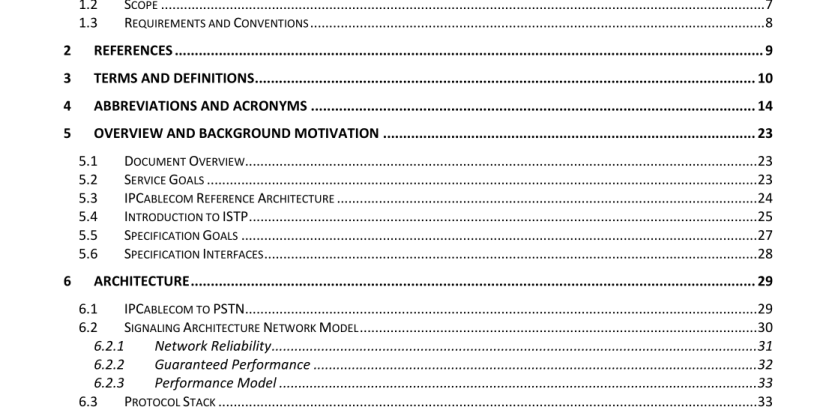ANSI SCTE 24-11-2016 pdf download.Internet Signaling Transport Protocol (ISTP)
1.1 Purpose
This specification describes the Internet Signaling Transport Protocol (ISTP) for IPCablecom PSTN Signaling Gateways. ISTP is being defined as part of the IPCablecom project. It is issued to support design and field-testing leading to the ability of multiple vendors to manufacture interoperable hardware and software. ISTP is a protocol that provides a signaling interconnection service between the IPCablecom network control elements (Call Management Server and Media Gateway Controller) and the PSTN SS7 Signaling network through the SS7 Signaling Gateway. ISTP contains features for initialization; address mapping from the SS7 domain to the IP domain; message delivery for SS7 ISUP and TCAP; congestion management, fault management, maintenance operations; and redundant configuration support. ISTP bridges the gap between basic IP transport mechanisms and application level signaling. Although not a translation of the SS7 MTP3 and SCCP protocols, ISTP implements analogues to some of the MTP3 and SCCP functions in a fashion appropriate to distributed systems communicating over an IP network. In order to meet the performance and reliability requirements mandated by the IPCablecom Service Requirements Specification and SS7 interconnection, ISTP requires the services of an underlying reliable transport service. The reliable transport provided by the Stream Control Transport Protocol (SCTP) as defined in the IETF SIGTRAN is the preferred solution; however, managed TCP over IP network may be used as an alternative. In order to guarantee at least a base level of interoperability between SS7 Signaling Gateways and the IPCablecom control elements, an addendum to this specification is planned that will detail an IPCablecom usage profile for ANSI ISUP and TCAP. A provisionable option will allow the Signaling Gateways to pass the native SS7 signaling messages instead of the profiled ANSI messages.
1.2 Scope
This document addresses the protocol to implement SS7 signaling interconnection in a distributed IPCablecom PSTN Gateway architecture. Specifically, it defines the messages and procedures for transporting SS7 ISUP, TCAP, and TUP messages between the IPCablecom control functions (Media Gateway Controller and Call Management Server) and the SS7 Signaling Gateway.
In addition, note that from time to time this document refers to the voice communications capabilities of an IPCablecom network in terms of “IP Telephony.” The legal/regulatory classification of IP-based voice communications provided over cable networks and otherwise, and the legal/regulatory obligations, if any, borne by providers of such voice communications, are not yet fully defined by appropriate legal and regulatory authorities and are beyond the scope of this document. Nothing in this document is addressed to, or intended to affect, those issues. In particular, while this document uses standard terms such as “call,” “call signaling,” “telephony,” etc., it should be recalled that while an IPCablecom network performs activities analogous to these PSTN functions, the manner by which it does so differs considerably from the manner in which they are performed in the PSTN by telecommunications carriers, and that these differences may be significant for legal/regulatory purposes. Moreover, while reference is made here to “IP Telephony,” it should be recognized that this term embraces a number of different technologies and network architecture, each with different potential associated legal/regulatory obligations. No particular legal/regulatory consequences are assumed or implied by the use of this term.
The legal/regulatory classification of IP-based voice communications provided over cable networks and otherwise, and the legal/regulatory obligations, if any, borne by providers of such voice communications, are not yet fully defined by appropriate legal and regulatory authorities. Nothing in this specification is addressed to, or intended to affect, those issues. In particular, while this document uses standard terms such as “call,” “call signaling,” “telephony,” etc., it will be evident from this document that while an IPCablecom network performs activities analogous to these PSTN functions, the manner by which it does so differs considerably from the manner in which they are performed in the PSTN by telecommunications carriers. These differences may be significant for legal/regulatory purposes.ANSI SCTE 24-11-2016 pdf download
